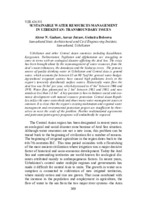| dc.contributor.author | Gadaev, A. | ru |
| dc.contributor.author | Juraev, A. | ru |
| dc.contributor.author | Boboeva, G. | ru |
| dc.coverage.spatial | Минск | ru |
| dc.date.accessioned | 2020-01-23T12:53:12Z | |
| dc.date.available | 2020-01-23T12:53:12Z | |
| dc.date.issued | 2019 | |
| dc.identifier.citation | Gadaev, A. Sustainable water resources management in uzbekistan: transboundary issues / A. Gadaev, A. Juraev, G. Boboeva // Социально-экономические и экологические проблемы горной промышленности, строительства и энергетики : сборник материалов 15-ой Международной конференции по проблемам горной промышленности, строительства и энергетики, 29–30 октября 2019 г., Минск – Тула – Донецк : в 4 т. / ред.: А. Б. Копылов, И. А. Басалай ; Белорусский национальный технический университет, Тульский государственный университет, Донецкий национальный технический университет. – Минск : БНТУ, 2019. – Т. 1. – С. 309-312. | ru |
| dc.identifier.uri | https://rep.bntu.by/handle/data/63112 | |
| dc.description.abstract | Uzbekistan and other Central Asian countries including Kazakhstan, Kyrgyzstan, Turkmenistan, Tajikistan and Afghanistan are struggling to come to terms with an ecological disaster affecting the Aral Sea. The crisis has been brought about by the mismanagement of water resources from the Aral’s main tributaries, the Amudarya and the Sirdarya rivers. The primary source of quality drinking water in Uzbekistan and Central Asia is ground water, which accounts for between 85 an 90 % of the general water budget. Agricultural irrigation systems have caused high pollutions levels in the region’s (unevenly distributed) surface waters. Historically water flow the Aral Sea was 56 km3 per year, which decreased to 47 km3 between 1966 and 1970. Water flow plummeted to 2 km3 between 1981 and 1983, and now stands at less than 1,8 km3. A key question is how to balance social and economic development with natural resource protection. Central Asian Republics utilize the same watersheds and share many water management issues in common. It is clear that the region’s existing multination and regional water management and environmental protection project are insufficient by themselves to meet the scale of the problem. Further multinational agreements and joint-state/joint-agency programs will undoubtedly be required. | ru |
| dc.language.iso | ru | ru |
| dc.publisher | БНТУ | ru |
| dc.title | Sustainable water resources management in uzbekistan: transboundary issues | ru |
| dc.type | Working Paper | ru |

